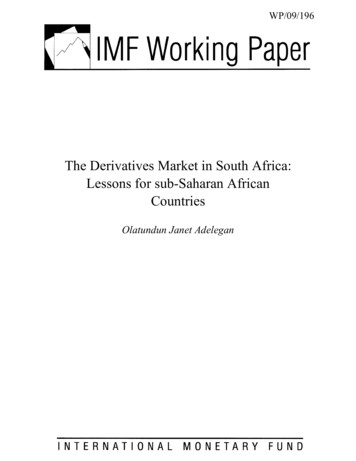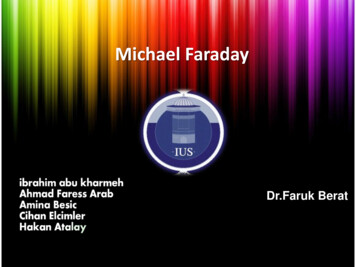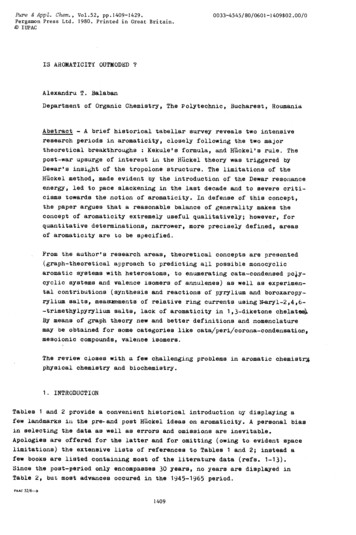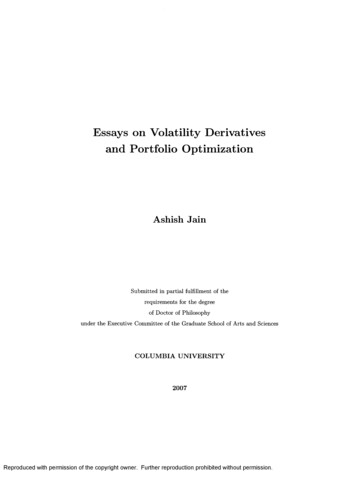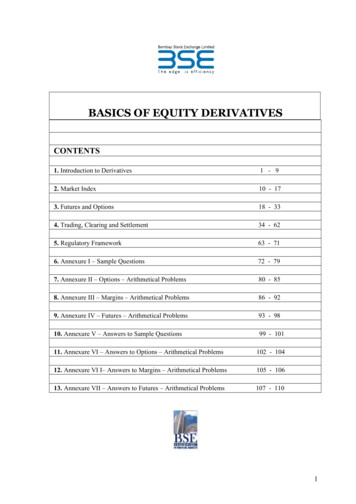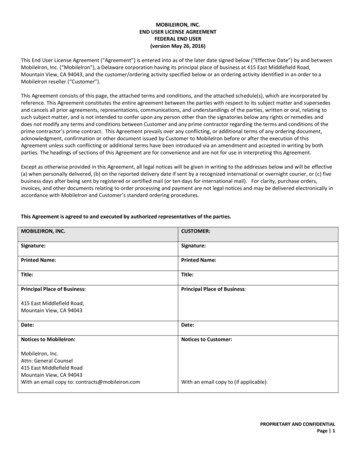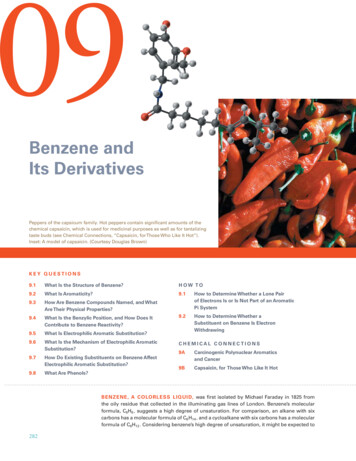
Transcription
09Benzene andIts DerivativesPeppers of the capsicum family. Hot peppers contain significant amounts of thechemical capsaicin, which is used for medicinal purposes as well as for tantalizingtaste buds (see Chemical Connections, “Capsaicin, for Those Who Like It Hot”).Inset: A model of capsaicin. (Courtesy Douglas Brown)KEY QUESTIONS9.1What Is the Structure of Benzene?HOW TO9.2What Is Aromaticity?9.19.3How Are Benzene Compounds Named, and WhatAre Their Physical Properties?How to Determine Whether a Lone Pairof Electrons Is or Is Not Part of an AromaticPi System9.4What Is the Benzylic Position, and How Does ItContribute to Benzene Reactivity?9.29.5What Is Electrophilic Aromatic Substitution?How to Determine Whether aSubstituent on Benzene Is ElectronWithdrawing9.6What Is the Mechanism of Electrophilic AromaticSubstitution?9.7How Do Existing Substituents on Benzene AffectElectrophilic Aromatic Substitution?9.8What Are Phenols?CHEMICAL CONNECTIONS9ACarcinogenic Polynuclear Aromaticsand Cancer9BCapsaicin, for Those Who Like It HotB EN Z EN E , A C O LORLESS LIQUID, was first isolated by Michael Faraday in 1825 fromthe oily residue that collected in the illuminating gas lines of London. Benzene’s molecularformula, C6H6 , suggests a high degree of unsaturation. For comparison, an alkane with sixcarbons has a molecular formula of C6 H14 , and a cycloalkane with six carbons has a molecularformula of C6H12 . Considering benzene’s high degree of unsaturation, it might be expected to282
9.1What Is the Structure of Benzene?show many of the reactions characteristic of alkenes. Yet, benzene is remarkably unreactive!It does not undergo the addition, oxidation, and reduction reactions characteristic of alkenes.For example, benzene does not react with bromine, hydrogen chloride, or other reagents thatusually add to carbon–carbon double bonds. Nor is benzene oxidized by peracids under conditions that readily oxidize alkenes. When benzene reacts, it does so by substitution in whicha hydrogen atom is replaced by another atom or a group of atoms.The term aromatic was originally used to classify benzene and its derivatives becausemany of them have distinctive odors. It became clear, however, that a sounder classificationfor these compounds would be one based on structure and chemical reactivity, not aroma.As it is now used, the term aromatic refers instead to the fact that benzene and its derivativesare highly unsaturated compounds that are unexpectedly stable toward reagents that reactwith alkenes.We use the term arene to describe aromatic hydrocarbons, by analogy with alkane andalkene. Benzene is the parent arene. Just as we call a group derived by the removal of an Hfrom an alkane an alkyl group and give it the symbol R J , we call a group derived by theremoval of an H from an arene an aryl group and give it the symbol Ar J .9.1What Is the Structure of Benzene?Let us imagine ourselves in the mid-nineteenth century and examine the evidence onwhich chemists attempted to build a model for the structure of benzene. First, because themolecular formula of benzene is C6 H6 , it seemed clear that the molecule must be highlyunsaturated. Yet benzene does not show the chemical properties of alkenes, the only unsaturated hydrocarbons known at that time. Benzene does undergo chemical reactions, butits characteristic reaction is substitution rather than addition. When benzene is treated withbromine in the presence of ferric chloride as a catalyst, for example, only one compoundwith the molecular formula C6 H5 Br forms:C6H6Br2FeCl3 BenzeneC6H5BrHBrBromobenzeneChemists concluded, therefore, that all six carbons and all six hydrogens of benzene mustbe equivalent. When bromobenzene is treated with bromine in the presence of ferric chloride, three isomeric dibromobenzenes are formed:C6H5BrBr2BromobenzeneFeCl3 C6H4Br2HBrDibromobenzene(formed as a mixture ofthree constitutional isomers)For chemists in the mid-nineteenth century, the problem was to incorporate theseobservations, along with the accepted tetravalence of carbon, into a structural formula forbenzene. Before we examine their proposals, we should note that the problem of the structure of benzene and other aromatic hydrocarbons has occupied the efforts of chemists forover a century. It was not until the 1930s that chemists developed a general understandingof the unique structure and chemical properties of benzene and its derivatives.A. Kekulé’s Model of BenzeneThe first structure for benzene, proposed by August Kekulé in 1872, consisted of a sixmembered ring with alternating single and double bonds and with one hydrogen bondedto each carbon. Kekulé further proposed that the ring contains three double bonds thatshift back and forth so rapidly that the two forms cannot be separated. Each structure hasbecome known as a Kekulé structure.283Aromatic compound Aterm used to classifybenzene and its derivatives.Arene An aromatichydrocarbon.Aryl group A groupderived from an aromaticcompound (an arene) by theremoval of an H; given thesymbol Ar J .Ar J The symbol used foran aryl group, by analogywith R J for an alkyl group.
284CHAPTER 9Benzene and Its DerivativesKekulé incorrectly believed that the doublebonds of benzene rapidly shift back and forthHHHHCCCCCCΔHHA Kekulé structure,showing all atomsKekulé structuresas line-angle formulasBecause all of the carbons and hydrogens of Kekulé’s structure are equivalent, substituting bromine for any one of the hydrogens gives the same compound. Thus, Kekulé’sproposed structure was consistent with the fact that treating benzene with bromine in thepresence of ferric chloride gives only one compound with the molecular formula C6 H5 Br.His proposal also accounted for the fact that the bromination of bromobenzene givesthree (and only three) isomeric dibromobenzenes:BrBrBrBrBrFeCl3 Br2 ¡ HBrBrBrThe three isomeric dibromobenzenesAlthough Kekulé’s proposal was consistent with many experimental observations, itwas contested for years. The major objection was that it did not account for the unusualchemical behavior of benzene. If benzene contains three double bonds, why, his criticsasked, doesn’t it show the reactions typical of alkenes? Why doesn’t it add three moles ofbromine to form 1,2,3,4,5,6-hexabromocyclohexane? Why, instead, does benzene react bysubstitution rather than addition?B. The Orbital Overlap Model of BenzeneThe concepts of the hybridization of atomic orbitals and the theory of resonance, developed by Linus Pauling in the 1930s, provided the first adequate description of the structureof benzene. The carbon skeleton of benzene forms a regular hexagon with C J C J C andH J C J C bond angles of 120 . For this type of bonding, carbon uses sp2 hybrid orbitals(Section 1.6E). Each carbon forms sigma bonds to two adjacent carbons by the overlap ofsp2–sp2 hybrid orbitals and one sigma bond to hydrogen by the overlap of sp2–1s orbitals.As determined experimentally, all carbon–carbon bonds in benzene are the same length,1.39 Å, a value almost midway between the length of a single bond between sp3 hybridizedcarbons (1.54 Å) and that of a double bond between sp2 hybridized carbons (1.33 Å):H120 H1.09 ÅH120 C120 CCHsp 2 - sp 2CCC1.39 ÅHsp 2 -1sHEach carbon also has a single unhybridized 2p orbital that contains one electron.These six 2p orbitals lie perpendicular to the plane of the ring and overlap to form acontinuous pi cloud encompassing all six carbons. The electron density of the pi system of
9.1What Is the Structure of Benzene?a benzene ring lies in one torus (a doughnut-shaped region) above the planeof the ring and a second torus below the plane (Figure 9.1).H H H(a)HBenzene as a hybrid of two equivalentcontributing structuresEach Kekulé structure makes an equal contribution to the hybrid; thus, theC J C bonds are neither single nor double bonds, but something intermediate. We recognize that neither of these contributing structures exists (they aremerely alternative ways to pair 2p orbitals with no reason to prefer one overthe other) and that the actual structure is a superposition of both. Nevertheless, chemists continue to use a single contributing structure to represent thismolecule because it is as close as we can come to an accurate structure withinthe limitations of classical Lewis structures and the tetravalence of carbon.HHHHHD. The Resonance Energy of BenzeneResonance energy is the difference in energy between a resonance hybrid and its most stable hypothetical contributing structure. One way to estimate the resonance energy of benzene is to compare the heats of hydrogenation of cyclohexene and benzene (benzene can bemade to undergo hydrogenation under extreme conditions). In the presence of a transitionmetal catalyst, hydrogen readily reduces cyclohexene to cyclohexane (Section 5.6): H 0 120 kJ mol( 28.6 kcal mol)By contrast, benzene is reduced only very slowly to cyclohexane under these conditions.It is reduced more rapidly when heated and under a pressure of several hundred atmospheres of hydrogen:because benzene does not react readily with reagentsthat add to alkenes, hydrogenation of benzene must beperformed at extremely high pressuresNi200–300 atm H 3 H2HHOne of the postulates of resonance theory is that, if we can represent a molecule or ion by two or more contributing structures, then that moleculecannot be adequately represented by any single contributing structure. Werepresent benzene as a hybrid of two equivalent contributing structures,often referred to as Kekulé structures:Ni1–2 atm C. The Resonance Model of BenzeneH2 285 H 0 20 9 kJ mol( 4 9 .8 kcal mol)The catalytic reduction of an alkene is an exothermic reaction (Section 5.6B). The heatof hydrogenation per double bond varies somewhat with the degree of substitution of thedouble bond; for cyclohexene H 0 120 kJ/mol ( 28.6 kcal/mol). If we imagine benzene in which the 2p electrons do not overlap outside of their original C J C double bonds,a hypothetical compound with alternating single and double bonds, we might expect its heatof hydrogenation to be 3 120 359 kJ/mol ( 85.8 kcal/mol). Instead, the heat of hydrogenation of benzene is only 209 kJ/mol ( 49.8 kcal/mol). The difference of 150 kJ/mol(35.8 kcal/mol) between the expected value and the experimentally observed value is the resonance energy of benzene. Figure 9.2 shows these experimental results in the form of a graph.(b)FIGURE 9.1Orbital overlap model of thebonding in benzene. (a) Thecarbon, hydrogen framework.The six 2p orbitals, each withone electron, are shownuncombined. (b) The overlapof parallel 2p orbitals forms acontinuous pi cloud, shownby one torus above the planeof the ring and a secondbelow the plane of the ring.Resonance energy Thedifference in energybetween a resonance hybridand the most stable of itshypothetical contributingstructures.
286CHAPTER 9Benzene and Its DerivativesFIGURE 9.2The resonance energy ofbenzene, as determinedby a comparison of theheats of hydrogenation ofcyclohexene, benzene, andthe hypothetical benzene.Benzene with isolateddouble bonds(hypothetical)Resonanceenergy ofbenzene 3 H2EnergyBenzene 3 H2Cyclohexene H2-120 kJ/mol(-28.6 kcal/mol)-209 kJ/mol(-49.8 kcal/mol)150 kJ/mol(35.8 kcal/mol)compounds loweron the energy scaleare more stable-359 kJ/molCyclohexane(-85.8 kcal/mol)calculatedFor comparison, the strength of a carbon–carbon single bond is approximately333–418 kJ mol (80–100 kcal mol), and that of hydrogen bonding in water and lowmolecular-weight alcohols is approximately 8.4–21 kJ mol (2–5 kcal mol). Thus, althoughthe resonance energy of benzene is less than the strength of a carbon–carbon single bond, itis considerably greater than the strength of hydrogen bonding in water and alcohols. In Section 8.1C, we saw that hydrogen bonding has a dramatic effect on the physical properties ofalcohols compared with those of alkanes. In this chapter, we see that the resonance energy ofbenzene and other aromatic hydrocarbons has a dramatic effect on their chemical reactivity.Following are resonance energies for benzene and several other aromatichydrocarbons:Resonance energy[kJ/mol (kcal/mol)]9.2this criterion is also calledthe 4n 2 rule becausethe allowable numbersof pi electrons can bedetermined when n issubstituted by any integer,including zeroBenzene150 (35.8)Naphthalene255 (60.9)Anthracene347 (82.9)Phenanthrene381 (91.0)What Is Aromaticity?Many other types of molecules besides benzene and its derivatives show aromatic character;that is, they contain high degrees of unsaturation, yet fail to undergo characteristic alkeneaddition and oxidation–reduction reactions. What chemists had long sought to understandwere the principles underlying aromatic character. The German chemical physicist ErichHückel solved this problem in the 1930s.Hückel’s criteria are summarized as follows. To be aromatic, a ring must1. Have one 2p orbital on each of its atoms.2. Be planar or nearly planar, so that there is continuous overlap or nearly continuousoverlap of all 2p orbitals of the ring.3. Have 2, 6, 10, 14, 18, and so forth pi electrons in the cyclic arrangement of 2p orbitals.
9.2Benzene meets these criteria. It is cyclic, planar, has one 2p orbital on each carbon atomof the ring, and has 6 pi electrons (an aromatic sextet) in the cyclic arrangement of its 2porbitals.Let us apply these criteria to several heterocyclic compounds, all of which are aromatic. Pyridine and pyrimidine are heterocyclic analogs of benzene. In pyridine, one CHgroup of benzene is replaced by a nitrogen atom, and in pyrimidine, two CH groups arereplaced by nitrogen atoms:NNPyridineNPyrimidineEach molecule meets the Hückel criteria for aromaticity: Each is cyclic and planar, hasone 2p orbital on each atom of the ring, and has six electrons in the pi system. In pyridine, nitrogen is sp 2 hybridized, and its unshared pair of electrons occupies an sp 2 orbitalperpendicular to the 2p orbitals of the pi system and thus is not a part of the pi system.In pyrimidine, neither unshared pair of electrons of nitrogen is part of the pi system.The resonance energy of pyridine is 134 kJ mol (32.0 kcal mol), slightly less than that ofbenzene. The resonance energy of pyrimidine is 109 kJ mol (26.0 kcal mol).this orbital is perpendicular tothe six 2p orbitals of the pi systemNthis electron pair is not a partof the aromatic sextetPyridineDetermine Whether a Lone Pair of Electrons IsHOW TO 9.1wor Is Not Part of an Aromatic Pi System(a) First, determine whether the atom containing the lone pair of electrons ispart of a double bond. If it is part of a double bond, it is not possible for thelone pair to be part of the aromatic pi system.this lone pair of electrons cannot be part of thearomatic pi system because the nitrogen is alreadysharing two electrons through the pi bond with carbonNN(b) If the atom containing the lone pair of electrons is not part of a doublebond, it is possible for the lone pair of electrons to be part of the pi system.What Is Aromaticity?287Heterocyclic compoundAn organic compound thatcontains one or more atomsother than carbon in its ring.
288CHAPTER 9Benzene and Its DerivativesDetermine this by placing the atom in a hybridization state that placesthe lone pair of electrons in a p orbital. If this increases the number ofaromatic pi electrons to either 2, 6, 10, 14, and so on, then the lone pairof electrons is part of the pi aromatic system. If placing the lone pair ofelectrons in the pi system changes the total number of pi electrons to anyother number (e.g., 3–5, 7–9, etc.), the lone pair is not part of the aromaticpi system.a nitrogen atom with three single bonds is normally sp3hybridized. However, to determine if the lone pair of electronsbelongs in the pi system, we must change the hybridization ofnitrogen to sp2 so that the electrons can reside in a p orbitalthis electron pair is ina p orbital and is a partof the aromatic sextetThe lone pair on nitrogen gives thepi system six electrons. Therefore, thenitrogen should be sp2 hybridized.NHNH O NHNHThe lone pair gives the pi system eightelectrons. Therefore, the nitrogenshould not be sp2 hybridized. this electron pairis in an sp2 orbitaland is not a part ofthe aromatic sextetFuranThe five-membered-ring compounds furan, pyrrole, and imidazole are also aromatic:Nthis electron pair is ina p orbital and is a partof the aromatic sextetO Furan N H PyrroleFIGURE 9.3Origin of the six pi electrons(the aromatic sextet) infuran and pyrrole. Theresonance energy of furan is67 kJ/mol (16 kcal/mol); thatof pyrrole is 88 kJ/mol(21 kcal/mol).NNHHPyrroleImidazoleIn these planar compounds, each heteroatom is sp 2 hybridized, and its unhybridized2p orbital is part of a continuous cycle of five 2p orbitals. In furan, one unshared pairof electrons of the heteroatom lies in the unhybridized 2p orbital and is a part of the pisystem (Figure 9.3). The other unshared pair of electrons lies in an sp 2 hybrid orbital,perpendicular to the 2p orbitals, and is not a part of the pi system. In pyrrole, the unshared pair of electrons on nitrogen is part of the aromatic sextet. In imidazole, theunshared pair of electrons on one nitrogen is part of the aromatic sextet; the unsharedpair on the other nitrogen is not.Nature abounds with compounds having a heterocyclic aromatic ring fused to one ormore other rings. Two such compounds especially important in the biological world areindole and purine:NH2NH2HONNNNNNNHNHNHIndoleSerotonin(a neurotransmitter)NHPurineAdenine
9.3How Are Benzene Compounds Named, and What Are Their Physical Properties?289Indole contains a pyrrole ring fused with a benzene ring. Compounds derived from indole include the amino acid L-tryptophan (Section 18.2C) and the neurotransmitterserotonin. Purine contains a six-membered pyrimidine ring fused with a five-memberedimidazole ring. Adenine is one of the building blocks of deoxyribonucleic acids (DNA)and ribonucleic acids (RNA), as described in Chapter 20. It is also a component of thebiological oxidizing agent nicotinamide adenine dinucleotide, abbreviated NAD (Section 21.1B).EXAMPLE9.1Which of the following compounds are aromatic?ON(a)(b)O(c)(c)O S T R AT E G YDetermine whether each atom of the ring contains a 2porbital and whether the molecule is planar. If these criteriaare met, determine the number of pi electrons. Those having2, 6, 10, 14, and so on electrons are aromatic.SOLUTIONThis molecule is planar, and each atomof the ring contains a 2p orbital. There isa total of 6 pi electrons. The molecule isaromatic.This molecule is planar, and each atom ofthe ring contains a 2p orbital. There is atotal of 4 pi electrons. The molecule is notaromatic.N(a)O (b)PROBLEMTreat the molecule as planar for the purposes of determining aromaticity. Also,treat each carbon atom in the ring ascontaining a 2p orbital. That is, treat theoxygen atom as sp2 hybridized, so thatone of its lone pairs of electrons will enterthe pi electron system (if we do not dothis, the molecule cannot be aromaticbecause an oxygen atom with two lonepairs of electrons and two single bondsis normally sp3 hybridized). Despite thesespecial considerations, the molecule endsup with a total of eight pi electrons, sothe molecule is not aromatic. Because itis not aromatic, the oxygen has no drivingforce to be sp2 hybridized and is, in fact,sp3 hybridized. Also, the molecule has nodriving force to be planar, and in fact, themolecule is nonplanar.See problem 9.119.1Which of the following compounds are aromatic? HH(a) 9.3B(b)(c)O How Are Benzene Compounds Named,and What Are Their Physical Properties?A. Monosubstituted BenzenesMonosubstituted alkylbenzenes are named as derivatives of benzene; an example is ethylbenzene. The IUPAC system retains certain common names for several of the simplermonosubstituted alkylbenzenes. Examples are toluene (rather than methylbenzene) and
290CHAPTER 9Benzene and Its Derivativesstyrene (rather than phenylethylene):CH2CH3Benzenemp ( C)bp ( C)CH “ 5.580The common names phenol, aniline, benzaldehyde, benzoic acid, and anisole are also retained by the IUPAC 78mp ( C)bp ( C)Phenyl group C6H5 J ,the aryl group derived byremoving a hydrogen frombenzene.Benzyl group C6H5CH2 J ,the alkyl group derived byremoving a hydrogen fromthe methyl group of toluene.HOHOOHOCH3Benzoic acid123249Anisole-37154The physical properties of substituted benzenes vary depending on the nature of the substituent. Alkylbenzenes, like other hydrocarbons, are nonpolar and thus have lower boilingpoints than benzenes with polar substituents such as phenol, aniline, and benzoic acid.The melting points of substituted benzenes depend on whether or not their moleculescan be packed close together. Benzene, which has no substituents and is flat, can pack itsmolecules very closely, giving it a considerably higher melting point than many substitutedbenzenes.As noted in the introduction to Chapter 5, the substituent group derived by the loss ofan H from benzene is a phenyl group (Ph); that derived by the loss of an H from the methylgroup of toluene is a benzyl group (Bn):HBenzeneCH2 CH3Phenyl group (Ph)TolueneBenzyl group (Bn)In molecules containing other functional groups, phenyl groups and benzyl groups areoften named as substituents:CH 3PhOrtho (o) Refers to groupsoccupying positions 1 and 2on a benzene ring.Meta (m) Refers to groupsoccupying positions 1 and 3on a benzene ring.Para (p) Refers to groupsoccupying positions 1 and 4on a benzene ring. C C HPhCH 2CH 2OHPhCH 2Cl2-PhenylethanolBenzyl chlorideCH 3(Z )-2-Phenyl-2-buteneB. Disubstituted BenzenesWhen two substituents occur on a benzene ring, three constitutional isomers are possible.We locate substituents either by numbering the atoms of the ring or by using the locatorsortho, meta, and para. The numbers 1,2- are equivalent to ortho (Greek: straight); 1,3- tometa (Greek: after); and 1,4- to para (Greek: beyond).
9.3How Are Benzene Compounds Named, and What Are Their Physical Properties?291When one of the two substituents on the ring imparts a special name to the compound, as, for example, toluene, phenol, and aniline, then we name the compound as aderivative of that parent molecule. In this case, the special substituent occupies ring position number 1. The IUPAC system retains the common name xylene for the three isomericdimethylbenzenes. When neither group imparts a special name, we locate the two substituents and list them in alphabetical order before the ending -benzene. The carbon of thebenzene ring with the substituent of lower alphabetical ranking is numbered C-1.NH2CH3CH3CH2CH3ClCH3ClBr4-Bromotoluene(p -Bromotoluene)3-Chloroaniline(m -Chloroaniline)1,3-Dimethylbenzene(m -Xylene)1-Chloro-4-ethylbenzene(p -Chloroethylbenzene)C. Polysubstituted BenzenesWhen three or more substituents are present on a ring, we specify their locations by numbers. If one of the substituents imparts a special name, then the molecule is named as aderivative of that parent molecule. If none of the substituents imparts a special name, wenumber them to give the smallest set of numbers and list them in alphabetical order beforethe ending -benzene. In the following examples, the first compound is a derivative of toluene, and the second is a derivative of phenol. Because there is no special name for the thirdcompound, we list its three substituents in alphabetical order, followed by the word nol2-Bromo-1-ethyl-4nitrobenzene9.2Write names for these compounds:ClCOOHCH3(a)INO2(b)(c)Br(d)BrNO2S T R AT E G YFirst, determine whether one of the substituents imparts a special name to the benzene compound (e.g., toluene, phenol,aniline). Identify all substituents and list them in alphabetical order. Use numbers to indicate relative position. The locatorsortho, meta, or para can be used for disubstituted benzenes.
292CHAPTER 9Benzene and Its DerivativesSOLUTION(a) 3-Iodotoluene or m-iodotoluene (b) 3,5-Dibromobenzoic acid (c) 1-Chloro-2,4-dinitrobenzene(d) 3-PhenylpropeneSee problems 9.13, 9.14PROBLEM9.2Write names for these compounds:COOHOH(b)(a)(c)CH3Polynuclear aromatichydrocarbon A hydrocarboncontaining two or more fusedaromatic rings.Polynuclear aromatic hydrocarbons (PAHs) contain two or more aromatic rings,each pair of which shares two ring carbon atoms. Naphthalene, anthracene, and phenanthrene, the most common PAHs, and substances derived from them are found incoal tar and high-boiling petroleum residues. At one time, naphthalene was used as amoth repellent and insecticide in protecting woolens and furs, but its use has decreaseddue to the introduction of chlorinated hydrocarbons such as p-dichlorobenzene. Alsofound in coal tar are lesser amounts of benzo[a]pyrene. This compound is found aswell in the exhausts of gasoline-powered internal combustion engines (for example,automobile engines) and in cigarette smoke. Benzo[a]pyrene is a very potent carcinogen and mutagen.NaphthaleneAnthracene9.4Benzylic carbon An sp3hybridized carbon bondedto a benzene ring.PhenanthreneBenzo[a]pyreneWhat Is the Benzylic Position, and How DoesIt Contribute to Benzene Reactivity?As we have mentioned, benzene’s aromaticity causes it to resist many of the reactions thatalkenes typically undergo. However, chemists have been able to react benzene in otherways. This is fortunate because benzene rings are abundant in many of the compounds thatsociety depends upon, including various medications, plastics, and preservatives for food.We begin our discussion of benzene reactions with processes that take place not on the ringitself, but at the carbon immediately bonded to the benzene ring. This carbon is known asa benzylic carbon.
9.4What Is the Benzylic Position, and How Does It Contribute to Benzene Reactivity?Benzene is unaffected by strong oxidizing agents, such as H2 CrO4 and KMnO4 . Whenwe treat toluene with these oxidizing agents under vigorous conditions, the side-chainmethyl group is oxidized to a carboxyl group to give benzoic acid:CH3COOH H2CrO4 ¡Toluene Cr 3 Benzoic acidThe fact that the side-chain methyl group is oxidized, but the aromatic ring is unchanged, illustrates the remarkable chemical stability of the aromatic ring. Halogen andnitro substituents on an aromatic ring are unaffected by these oxidations. For example,chromic acid oxidizes 2-chloro-4-nitrotoluene to 2-chloro-4-nitrobenzoic acid. Notice thatin this oxidation, the nitro and chloro groups remain neChemicalChi lO2NCl2-Chloro-4-nitrobenzoic acid9ACo ect o sConnectionsC A R CI N OG EN I C POLYNU C L E AR AR O MAT IC S AND C ANC E RA carcinogen is a compound that causes cancer. Thefirst carcinogens to be identified were a group of polynuclear aromatic hydrocarbons, all of which have atleast four aromatic rings. Among them is benzo[a]pyrene, one of the most carcinogenic of the aromatichydrocarbons. It forms whenever there is incompletecombustion of organic compounds. Benzo[a]pyreneis found, for example, in cigarette smoke, automobileexhaust, and charcoal-broiled meats.Benzo[a]pyrene causes cancer in the followingway: Once it is absorbed or ingested, the body attempts to convert it into a more soluble compoundthat can be excreted easily. To this end, a seriesof enzyme-catalyzed reactions transforms benzo[a]pyrene into a diol epoxide, a compound that can bindto DNA by reacting with one of its amino groups,thereby altering the structure of DNA and producing acancer-causing eneQuestionShow how the outer perimeter of benzo[a]pyrenesatisfies Hückel’s criteria for aromaticity. Is the outerA diol epoxideperimeter of the highlighted portion of the diol epoxide product of benzo[a]pyrene also aromatic?293
294CHAPTER 9Benzene and Its DerivativesEthylbenzene and isopropylbenzene are also oxidized to benzoic acid under these conditions. The side chain of tert-butylbenzene, which has no benzylic hydrogen, is not affectedby these oxidizing conditions.benzylic carbonsbonded to at leastone hydrogen areoxidized H2CrO4COOHEthylbenzene Cr3 Benzoic acid H2CrO4benzylic carbons notbonded to hydrogenare not oxidizedIsopropylbenzene H2CrO4Noreactiontert-ButylbenzeneFrom these observations, we conclude that, if a benzylic hydrogen exists, then thebenzylic carbon (Section 9.3A) is oxidized to a carboxyl group and all other carbons of theside chain are removed. If no benzylic hydrogen exists, as in the case of tert-butylbenzene,then the side chain is not oxidized.If more than one alkyl side chain exists, each is oxidized to J COOH. Oxidationof m-xylene gives 1,3-benzenedicarboxylic acid, more commonly named isophthalicacid:CH3COOHH2CrO4CH3m -XyleneEXAMPLECOOH1,3-Benzenedicarboxylic acid(Isophthalic acid)9.3Predict the products resulting from vigorous oxidation of each compound by H2CrO4. The various by-products that are formedfrom benzylic oxidation reactions are usually not specified.(a) 1,4 -dimethylbenzene (p-xylene)(b)S T R AT E G YIdentify all the alkyl groups in the reactant. If a benzylic hydrogen exists on an alkyl group, chromic acid will oxidize it to aJ COOH group.
9.5What Is Electrophilic Aromatic Substitution?SOLUTIONchromic acid oxidizes both alkyl groups to COOH groups,and the product is terephthalic acid, one of two compoundsrequired for the synthesis of Dacron polyester and Mylar(Section O‘HOCO‘COH1,4-Benzenedicarboxylic acid(Terephthalic acid)H2CrO4(b)COOHthis alkyl group has no benzylichydrogens and is not oxidizedSee problem 9.30PROBLEM9.3Predict the products resulting from vigorous oxidation of each compound by H2 CrO4 :(a)(b)O2N9.5What Is Electrophilic Aromatic Substitution?Although benzene is resistant to most of the
286 CHAPTER 9 Benzene and Its Derivatives For comparison, the strength of a carbon–carbon single bond is appr

